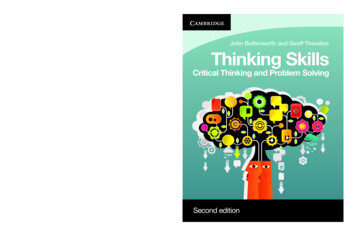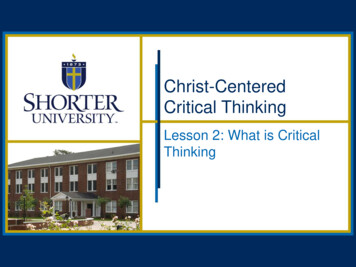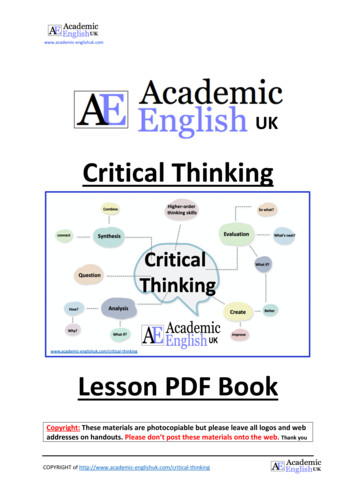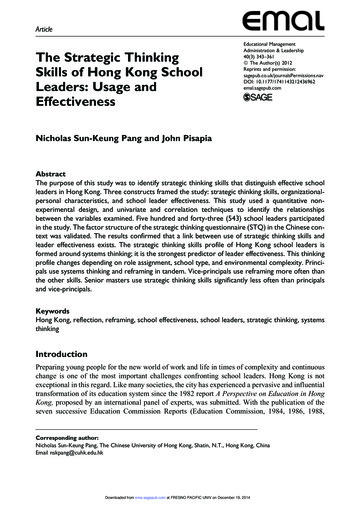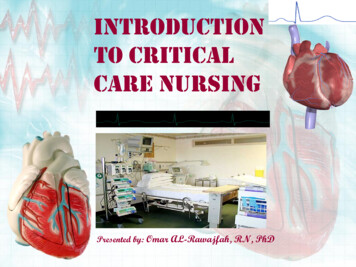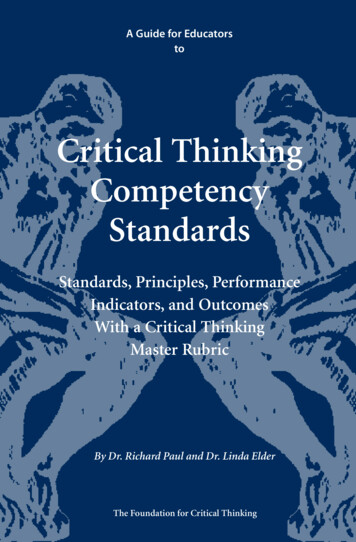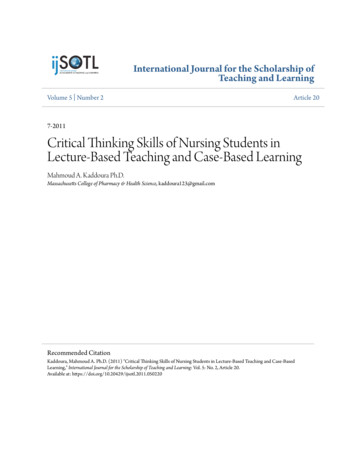
Transcription
International Journal for the Scholarship ofTeaching and LearningVolume 5 Number 2Article 207-2011Critical Thinking Skills of Nursing Students inLecture-Based Teaching and Case-Based LearningMahmoud A. Kaddoura Ph.D.Massachusetts College of Pharmacy & Health Science, kaddoura123@gmail.comRecommended CitationKaddoura, Mahmoud A. Ph.D. (2011) "Critical Thinking Skills of Nursing Students in Lecture-Based Teaching and Case-BasedLearning," International Journal for the Scholarship of Teaching and Learning: Vol. 5: No. 2, Article 20.Available at: https://doi.org/10.20429/ijsotl.2011.050220
Critical Thinking Skills of Nursing Students in Lecture-Based Teachingand Case-Based LearningAbstractIn today's technologically advanced healthcare world, nursing students should be active learners and thinkcritically to provide safe patient care. A strategy that promotes students' active learning is case-based learning(CBL). The purpose of this study was to examine critical thinking (CT) abilities of nursing students from twodifferent curricular approaches, CBL and didactic teaching. The design used in this research was a comparativedescriptive survey. The sample included 103 participants; 65 students from the CBL nursing program and 38students from the didactic nursing program offered by the MOH Schools of Nursing in the United ArabEmirates (UAE). Data were collected using the California Critical Thinking Skills Test (CCTST) Form B tomeasure the CT abilities of the participants. The data were analyzed using the SPSS. The independent t-testresults revealed that the CBL participants performed better in the total CT score and all CT subscales than thedidactic program participants.KeywordsCritical thinking, Didactic teaching, Case-based learning, Case studies, Cooperative learning, Active teachinglearning strategies
IJ-SoTL, Vol. 5 [2011], No. 2, Art. 20Critical Thinking Skills of Nursing Studentsin Lecture-Based Teaching and Case-Based LearningMahmoud A. KaddouraMassachusetts College of Pharmacy and Health SciencesBoston, Massachusetts, USA kaddoura123@yahoo.comAbstractIn today's technologically advanced healthcare world, nursing students should be activelearners and think critically to provide safe patient care. A strategy that promotes students'active learning is case-based learning (CBL). The purpose of this study was to examinecritical thinking (CT) abilities of nursing students from two different curricular approaches,CBL and didactic teaching. The design used in this research was a comparative descriptivesurvey. The sample included 103 participants; 65 students from the CBL nursing programand 38 students from the didactic nursing program offered by the MOH Schools of Nursingin the United Arab Emirates (UAE). Data were collected using the California Critical ThinkingSkills Test (CCTST) Form B to measure the CT abilities of the participants. The data wereanalyzed using the SPSS. The independent t-test results revealed that the CBL participantsperformed better in the total CT score and all CT subscales than the didactic programparticipants.Key Words: Critical thinking, didactic teaching, case-based learning, case studies,cooperative learning, active teaching-learning strategies.IntroductionThe world of nursing has been changing daily specially in the last two decades. In today'sfast paced, technologically advanced world, the challenge for nursing faculty is to teachstudents critical thinking (CT) skills and the ability to practice competently in a variety ofsituations. The rapidly changing nature of the health care system presents nurses withvaried complex practice issues with no clear solutions. These health care problems requirenursing students and nurses to have CT skills (Bambini, Washburn, & Perkins, 2009).Educators have to equip nursing students with skills that promote their CT to solve complexissues. The development of CT skills requires students to engage in discussions to becomeactive participants in their own learning (Bucy, 2006). A major strategy that promotesstudents' active learning and provides their prudent preparation for clinical practice is CBL;case-based learning (Lowenstein & Bradshaw, 2001).According to Lowenstein and Bradshaw (2001), CBL engages students and teachers inanalytic dialogue about nursing situations by helping learners analyze an authentic case toidentify client problems, compare and evaluate optional solutions, and decide how to dealwith clinical situations. CBL demands active participation from learners, and it supportsprofessional practice goals by encouraging learner-teacher interactions. It also offersstudents opportunities to discuss real-life situations and nursing challenges in a safeenvironment and stimulates students “to think critically since the cases offer no concreteanswers" (Chen & Lin, 2003, p. 138).https://doi.org/10.20429/ijsotl.2011.0502201
Critical Thinking Skills of Nursing Students in Lecture-Based TeachingUsing CBL prepares students for the principles of CT, which has become an essentialoutcome in most schools of nursing today. No matter what type of program studentsattended previously this skill has been fundamental to their practice. Nursing faculty striveto prepare nurses who think critically in order to elicit and interpret information, integratemultiple sources of data; solve clinical problems, make sound clinical judgment and providelogical scientific rationale for their decision-making process (Gentner, Loewenstein, &Thompson, 2003).The staff of the Ministry of Health (MOH) Institutes of Nursing in the United Arab Emirates(UAE), which are managed by the same general director and offer the same nursingcurriculum, recognized the significance of CT in nursing education. The method of teachinginstruction had been the didactic, face to face teaching strategy in all the MOH Institutes.Needs assessment was done by the MOH to assess the satisfaction of the MOH hospitals, inwhich the vast majority of the nursing graduates were employed, with the performance ofthose graduates. The results revealed a major concern with the ability of the graduates toapply the knowledge they learned at the Institutes of Nursing to solve critical problems andmake sound decisions related to effective patient care.Based on the feedback of the hospitals’ nurse managers, the Institutes of Nursing facultyand administration sought ways in which students graduating from their nursing programcould be equipped to meet the challenges presented by the demand for independentthought in clinical decision making. A strategic review of the didactic nursing program tookplace and led to a complete review of their nursing curriculum to integrate teaching andlearning activities that develops students’ CT.However, it was not clear to them which type of curriculum to adopt due to lack ofexperience in using any other curriculum, apart from the didactic teaching, in the entire gulfregion. This uncertainty of what curriculum could be appropriate to espouse was alsoattributed to lack of adequate literature on teaching and learning strategies that promotestudents’ CT skills. After consulting with a western university, a suggestion was to adopt thecase-based learning (CBL) curriculum and conduct research to evaluate its effectiveness interms of its impact on the students’ CT. This was done by progressively replacing thetraditional lecture-based teaching program, which was perceived by the MOH hospitals andInstitutes of Nursing administration as not conducive to students’ CT, by the CBL as anapproach to facilitate students’ learning by using relevant case studies and discussion toengage students in all courses. Yet, this study was the first of its kind in the gulf region,including the UAE.The nursing program at the Institutes of Nursing is a three-year Diploma program designedfor students who hold an official Secondary School (high school) Certificate from the UAE, orits equivalent. The language of instruction at the Institutes is English. In each semester anEnglish course is offered according to the educational developmental needs of the students.The ultimate goal of these courses is to maintain academic professional functioning sinceEnglish is the language used in all health care facilities in the multicultural society of theUAE. The mission of the Institutes is to prepare a nursing workforce (from the UAE and Arabcitizens) that is responsive to the actual and potential health needs of the UAE community,wherever they reside. The program is committed to the preparation of generalist, Arabicspeaking nurses who employ the nursing process and CT skills in meeting the human needsof clients as individuals, families and communities throughout the life span. Recently, theMOH signed an agreement with the Higher Colleges of Technology, the other major providerof nursing programs in the UAE, to collaborate in the delivery, management, teaching andhttps://doi.org/10.20429/ijsotl.2011.0502202
IJ-SoTL, Vol. 5 [2011], No. 2, Art. 20evaluation of the Bachelor of Science in Nursing at the three Federal Institutes of Nursing atSharja, Ras Al Khaima and Fujaira.As mentioned earlier, the Institutes of Nursing have undergone changes in an endeavour topromote students’ CT. These changes have affected the students and faculties’ roles. TheCBL adopted nowadays in the Institutes promotes a process-oriented curriculum, in whichthe teacher becomes acting as a facilitator of the teaching-learning process. Students areexpected to be active participants in the process and develop skills of problem solving andCT in a collaborative approach to the care of patients, who are the major focus of the nursingprogram. Presently, the three Institutes of Nursing are maintained uniformly under thecentral management of Higher Administration located in Sharja Campus. Despite thedocumented importance of applying CT skills in nursing education, there is a noticed dearthof research exploring the development of these skills among nursing students in the UAE.Very little has been done in the UAE in terms of empirical research comparing the influenceof various teaching-learning approaches, particularly traditional lecture-based teaching andCBL, in facilitating the development of nursing students’ CT skills. Specifically, prior to thisstudy, no research was done to investigate the development of CT skills in the traditionaldidactic or the adopted CBL curriculum in the MOH Institutes of Nursing in the UAE andneighbourhood countries. For this reason, this study was conducted in an attempt to answerthe following research question: “Will there be a significant difference in the CT abilitybetween nursing students educated using the CBL program and those homogeneousstudents educated using the traditional lecture-based program?"PurposeThis study examined CT skills of nursing students from two different approaches, a CBL anda traditional lecture-based nursing program. The purpose was to compare the difference inCT abilities of the participants from both nursing programs. The objectives of this studywere to:1.2.3.Measure CT skills of nursing students educated using a didactic nursingprogram.Measure CT skills of nursing students educated using a CBL nursing program.Compare the level of CT of nursing students educated using a didactic nursingprogram to the level of CT of nursing students educated using a CBL nursingprogram.The Null HypothesisThere will be no significant difference in the CT scores between nursing students educatedusing the CBL program and those students educated using the traditional lecture-basedprogram.Review of Relevant LiteratureCritical Thinking (CT)There is no standard, universally accepted, all-inclusive framework or set of criteria bywhich to describe or evaluate CT (Myrick, 2002). Varied CT definitions and perspectiveshave been proposed. Some authors included cognitive skills and attitudes in theirdescription of CT (Profetto-McGrath, 2003). Other authors expanded the CT definition toinclude investigation and reflection on all aspects of clinical problems to decide on anhttps://doi.org/10.20429/ijsotl.2011.0502203
Critical Thinking Skills of Nursing Students in Lecture-Based Teachingappropriate course of action (Bowles, 2000). Morrison and Walsh-Free (2001) asserted thatCT incorporates assessment and multi-logical thinking as a key requirement for nurses tobe able to relate and apply concepts to clinical situations. Giancarlo, Blohm, and Urdanasserted that, “CT is widely recognized as an essential component of education and apowerful and vital resource in one’s personal and civic life” (2004, p. 347). According toCase, “Every curriculum document mentions CT, and there is universal agreement aboutthe need to make thoughtful judgments in virtually every aspect of our lives - from whoand what to believe to how and when to act” (2005, p. 45).Critical thinking is described in many ways, but is most importantly viewed as a processrather than an endpoint or objective (Petress, 2004). Critical thinking is not limited todisciplines, knowledge, or experience and occurs within and across all these domains (Paul& Elder, 2002). Critical thinking is developed through reflection both on experience andknowledge. Giancarlo and Facione (2007) asserted that CT is a disciplined, self-directedcognitive process leading to high quality decisions and judgments through the analysis,assessment and reformulation of thinking. The operational definition of CT used for thisstudy was the one described by Facione (2006) that involves identifying problems,assessing resources and generating possible solutions. This definition has frequently beenused in the fields of nursing and education. According to Facione (2006), CT skills includethe ability to analyze, synthesize, infer, and evaluate situations.Today, more than ever, nursing students should demonstrate mastery of CT skills prior totheir graduation from their respective nursing school. Critical thinking has been consideredan essential nursing competency since 1997 (Shirrell, 2008). It has been a controversialissue whether CT is a concept that can be taught. As a case in point, Facione (2006) arguedthat CT skills can be taught and learned. Case (2005, p. 45) stated that he “is disheartenedby the failures to teach CT.” A research study by Tanner (2005) about teaching students tothink critically was inconclusive revealing that there is no consistent relationship betweenteacher CT and student CT. It is important for nurses to develop CT, problem solving, andreflective practice techniques to expand their clinical decision-making skills (Hoffman,Duffield, & Donoghue, 2004).Traditional Educational ProgramsTraditional educational curricula are didactic, teacher-centered teaching methods organizedaround subject areas or disciplines (Burgan, 2006). A prominent feature of such aneducational philosophy is a hierarchical view of teacher and students, in which the facultyteaches, and students learn by listening to the teacher. The teacher delivers structuredpackages of theoretical or practical knowledge complete with analysis, insight, andconclusions, while students are expected to take notes, memorize and master the impartedinformation (Loving & Wilson, 2000). Hence, the traditional classroom is teacher-centered,with students passively accepting information given by the lecturer, who is in the positionof authority. The teacher decides about the teaching-learning process. A traditionalteaching-learning environment tends to produce shallow, surface thinkers who primarilyrely on rote memory rather than careful understanding of the content (Jeffries, 2005).It has been argued that outcomes of didactic learning fail to exhibit a patient-oriented;critically thinking nurse capable of adequate decision making in practice, as lecturingprincipally provide basic knowledge and theory (Royse & Newton, 2007). Lecturing has beena traditional method of teaching nursing students with or without the use of PowerPointslides to pass on the content to the students. It provides the foundation for the applicationof knowledge to real-life scenarios and complex health problems (Flanagan & McCausland,2007). The didactic lecture-based teaching approach is associated with 11.0502204
IJ-SoTL, Vol. 5 [2011], No. 2, Art. 20environments, where teachers provide information to students, who reproduce theinformation in examinations or assignments (Barrett, Bower, & Donovan, 2007). There aresome advantages for lecturing in the way that novice nursing students need teaching onunfamiliar information and how to use the acquired information (Burgan, 2006). Whenlecture-based teaching is used in conjunction with active teaching strategies such asanalytical questioning and group discussion it helps students with the acquisition ofknowledge. According to Charlton (2006), lectures are for the most part a form of spokencommunication that is delivered to an audience by an actually-present and visible person.Lectures create a formally arranged social event that fits human nature and artificiallymanipulates human psychology to improve learning (Charlton, 2006). Once combined withactive learning strategies, teaching becomes a process where the learner takes an energeticrole in education. Active learning is usually enjoyable, motivational and effective, andretention of knowledge is perceived to be increased (Petress, 2008). According toRichardson (2008), the key student behavior that brings about active learning isengagement. Basic elements of active learning include talking, listening, reading, writingand reflecting (Karamustafoglu, Costu, & Ayas, 2006). According to Kane (2001), it issatisfying for educators to think that students might enjoy themselves while being engagedin their learning, as they learn something useful.Case-Based Learning (CBL)CBL is an instructional method within the context of student-centered learning to facilitatestudents’ learning and teach them to decide about their perspective field, by the use of casestudies. The teacher in this method presents a case study that mimics a genuine clinicalsituation from a proper healthcare facility and asks the students various questions about thecase (Woody, Albrecht, Hines, & Hodgson, 1999). This teaching method was first introducedin the 1870s by Harvard school faculty. It has been used for many years in business and lawschools at Harvard University. Then, it was implemented in the medical and healthprofessions schools. Lately, CBL has been adopted by various disciplines including nursingboth as a teaching strategy and as a problem-solving and decision-making tool. Casestudies often are long and detailed, describing fairly well-defined problems. Learners canapply their background knowledge as well as new learning to solve the problem (DeYoung,2003). Because the primary aim of CBL is to develop CT and problem-solving skills, itsapplication has been used in nursing education (Down & Davidhizar, 1999). The cases inCBL help build on prior knowledge, integrate data, and consider application to futuresituations. Cases encourage teamwork and accountability, and are realistic and motivatingto adult learners to be engaged in their learning to think about plausible answers instead ofpassively receiving the information (Bastable, 2003).Rowles and Brigham (2005) suggest the following five guidelines for effective use of casestudies: 1). the case study needs to focus on the most important concepts to be learned;2). as case studies may not have one right answer, the teacher should consider alternativeresponses and ask students analytical questions for further discussion of the case. 3). thelearning environment needs to be open, safe, and nonthreatening to facilitate students'participation. 4). all students should be engaged in the learning activity if class size allows.5). summarization of key points is essential to ensure that students take away the mostimportant concepts. According to Schodt (2000), CBL can be defined by contrasting it withthe traditional lecture-based method. Instead of textbooks, the CBL method uses cases ofdescription of specific situations as a narrative of a realistic problem that typically, but notalways, represents real clinical situations that enable students to discover and develop theirown unique framework for dealing with the case. Case-based teaching has been found tohttps://doi.org/10.20429/ijsotl.2011.0502205
Critical Thinking Skills of Nursing Students in Lecture-Based Teachingbe a more effective instructional method than conventional lecture-based teaching forpromoting students’ CT and decision-making skills (Carter, 1999).CBL is a teaching method that integrates concepts, theories and practice over time in avariety of settings. It promotes reflection, teacher-student dialogue, and group discussions(Ferrario, 2003). Case developers can provide guidelines for customizing the content tomatch the learner levels (Morrow et al, 2003). Abboud (2000) averred that CBL is a processby which students learn by using a clinical presentation as a stimulus to acquire additionalknowledge on a clinical entity to solve problems. Uys (1998) purported that CBL focusesstrongly on the process of learning and covers the required content through a set ofcomplete cases, yet she balanced the process with the content. Gwele (1999) emphasizedthat CBL offers learners opportunities to make meaning of their own world of nursingthrough active participation in their own learning, developing inquiring minds and awarenessof knowledge. Cases that approximate real-world settings increase the likelihood thatlearners will transfer their learning from one setting to another (Weiss & Levison, 2000).Cases should reflect the backgrounds, needs and diversity of learners. They should addressthe goals and objectives of both learners who are challenged to analyze problems presentedin cases and make rational inferences (Snyder & McWilliam, 2003).Instructional methods for improving the process of CBL include building up students’ priorknowledge; assessing students’ knowledge and skills; providing specific feedback tostudents, and embedding various teaching aids to support student learning (Eshach &Bitterman, 2003). Cases should be designed in a thoughtful way to help reinforce thestudent’s prior knowledge by allowing learners to progressively use the most recentlyacquired materials (Leong, Baldwin, & Adelman, 2003). Cases should reveal to learnersthe outcomes of their choices, both positive and negative, to help learners’ self-assessment(Malloy, 2002). CBL aims at keeping learners engaged in thinking about answers to thecases to help them identify learning needs and explain sound scientific rationales for theirchoices (Thomas et al., 2001).MethodologyDesignThis study compared lecture-based teaching and CBL programs in terms of CT development.The design used in this quantitative research was a comparative descriptive survey as itexamined and described differences in CT skills of participants in the lecture-based teachingand the CBL programs.Participants and SettingThe researcher used a convenient sample of 103 participants. The sample included all thethird year nursing students (N 65) enrolled in the CBL nursing diploma program and thethird year nursing students (N 38) from the traditional lecture-based diploma programoffered by the MOH Institutes of Nursing in the United Arab Emirates (UAE). The studentsin the CBL group were in Sharja branch and those in the didactic program were in Fujeirabranch of the MOH Institutes of Nursing. The Sharja and Fujeira Institutes of Nursing werechosen to be included in this study as they are both MOH institutes of Nursing that teachnational Emirati and expatriate students. Both tend to offer the same diploma nursingcourses for comparable student populations (with similar characteristics) in the UAE.Students from both groups received the same instructional content and the same examsoverseen by the same central course coordinator who ensures consistency among thehttps://doi.org/10.20429/ijsotl.2011.0502206
IJ-SoTL, Vol. 5 [2011], No. 2, Art. 20Institutes of Nursing in terms of courses’ syllabi, assessment and evaluation. Before theirenrolment in the three-year diploma-nursing program, all of the participants graduated fromhigh schools that followed the traditional didactic teaching method with a general average oftheir cumulative grades exceeding 70 % (the two Institutes have similar admission criteriain terms of GPA, gender, age, and English proficiency level). The only difference betweenthe two groups was the mode of delivery of the content. The CBL students were educatedusing Power Point slides and cases studies for three years. However, the lecture-basedstudents were educated through didactic lecture-based method using only Power Pointslides and were never exposed to CBL prior to the conduction of this study, although theplan was to change their entire curriculum to CBL the following year. For the sake of thisstudy, the same instructor taught both sections.Interventions/practical activitiesThe courses’ content and syllabi for both groups were designed by the same academiccoordinator who coordinated all courses taught at the Institutes of Nursing. Although bothgroups received the same instructional materials, textbooks, tests, assignments andevaluations, the didactic group was educated using a didactic teaching using the samePowerPoint slides of the CBL group that only received additional practical activities. Thesame power point slides were used for both groups and these slides were prepared by thecourse coordinator. The CBL interventions included case studies, which were interspersedbetween Power Point lectures throughout the curriculum. Each case study required studentsto work in groups in the class to discuss the questions the teacher poses related to thecases. The nursing students were introduced to complex health problems that presentedwith similar signs and symptoms such as neurological, cardiovascular, respiratory, digestive,urinary tract diseases, etc.While the teacher of the didactic group was lecturing the same material for the students whowere listening to him/her, the teacher of the CBL group was seating the students in smallgroups of five to six, asking questions, and wandering around the classroom to ensure thatall students were engaged in their learning by participating in the discussions. By lecturing,the didactic teacher was helping the students understand the content, complete theirassignments, and pass the tests. On the other hand, by using case studies, the CBLfacilitator was trying to help students achieve similar goals by discovering and constructingknowledge instead of just transferring the knowledge to the students.InstrumentThe California Critical Thinking Skills Test (CCTST) Form B was used to collect data on CTabilities of the participants. It is an intellectually challenging standardized 34 item multiplechoice instrument administered over a 45 minutes period to test cognitive skills. The itemsare based on common topics intended to be of short, discipline-neutral content; problemstatements; and scenarios grouped into six subscales including analysis, evaluation,inference, explanation, interpretation, and self-regulation (Facione, 2006). According toFacione (2006), the possible scores on the CCTST total scores can range from 0 to 34.Moreover, sub-scale scores on the instrument can range as follows: Analysis (0 to 9);Evaluation (0 to 14); Inference (0 to 11); Deductive reasoning (0 to 16); and Inductivereasoning (0 to 14). The sum of the scores of analysis, evaluation, and inference is equalto the CCTST total score. The inductive and deductive scales overlap with the analysis,inference, and evaluation scales (Facione, 2006)The CCTST has undergone a number of psychometric tests by its developers. The internalreliability of 0.78 to 0.84 was computed using Kuder-Richardson (KR-20) internalconsistency coefficients. Content validity was undertaken in a previous stage ofhttps://doi.org/10.20429/ijsotl.2011.0502207
Critical Thinking Skills of Nursing Students in Lecture-Based Teachingdevelopment of the CCTST, which involved 46 national experts who participated in a Delphisurvey. Concurrent validity was measured by correlating the CCTST with college entryscores such as the Scholastic Aptitude Test verbal scores (correlation alpha 0.55) and theGRE (0.72). Construct validity was supported by significant correlation between CCTST andstudent gender, ethnicity, academic major and self-esteem when administered to 1196university students scores (Facione, 2006).For the UAE context, the feasibility and use of the CCTST was validated by a pilot study,which was conducted almost three weeks prior to the data collection. The CCTST (Form B)was administered by a facilitator to a small convenient sample of twenty five senior diplomanursing students Ras Al Khaima MOH Institute of Nursing that was not included in the actualstudy. This pilot study was meant to test the feasibility of using the CCTST with the UAEstudents whom, in addition to being a culturally different group from the original group onwhich the instrument was tested by its developers, are also not native English languagespeakers.The results of this pilot study helped the researcher to check the English understanding ofthe test. It anticipated the sort of understanding of the questions by the students.Moreover, it checked how long it took the students to complete the questionnaire. The timeranged from one hour to ninety minutes with an average of seventy-five minutes. TheCCTST was also sent to the English department at the MOH Institutes of nursing for theEnglish language director and faculty who teach the students to comment on the level ofunderstanding of the English language of the instrument. The results of the pilot study aswell as the feedback received from the Engl
nursing students and nurses to have CT skills (Bambini, Washburn, & Perkins, 2009). Educators have to equip nursing students with skills that promote their CT to solve complex issues. The development of CT skills requires students to engage in discussions to become active participants in their own learning (Bucy, 2006). A major strategy that .




